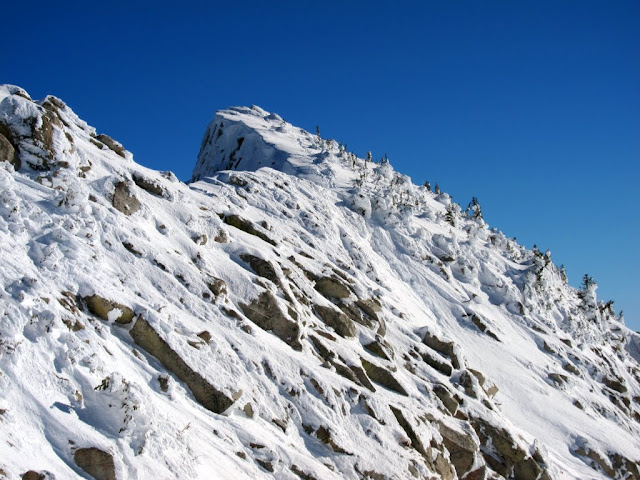With the nice weather window we've had, I was anxious to link up some peaks and good ski lines. Jason Dorais and Adam OK, both who are practitioners of the Go Light Go Far discipline, joined me for the action. Our plan for the day to climb Lone Peak via Bells and ski the Northeast chute and eventually end up at the Coalpit, where we dropped a car. Our approach from LCC road to the base of Lone Peak took about 2 hours. Here is Jason with Lone Peak in his sights:
There are easier ways to approach and climb Lone Peak, but I've always been intrigued with climbing the chute to the distinctive notch on far looker's right in the photo below (what I call the "Notch Couloir"). From below, the ridge from Notch Couloir looks like a fairly direct and skinnable line to the summit.
For me, Lone Peak is the grandest in the Wasatch. I've nearly driven off the road (a few times) as I've stared at it from the valley. Hence, yet another view.
I thought that climbing the Notch Couloir would give us a good sense of the NE Couloir's conditions, and it did. The bottom half was filled with decent compacted snow. The top half was a slick ice sheet that had expelled the month's snow onto the bottom half. Ever optimistic, we climbed the ice crusted chute to the top and then got scared and schooled by the exposure and the rock moves required to get up the notch. Here is Adam topping out:
And Jason standing on top of a big cliff above Big Willow:
The headwall at the top of the Notch contained some softer windblown, which we skied. It was
steep! As I booted down the icy section, I knew that we wouldn't be skiing the NE Couloir today. The apron was nice though.
Having just been kicked off Lone Peak, and having a lot more daylight left, we struck out for South Thunder. Here is a shot of its northeast aspect.
From there, we traversed the top of S Thunder Bowl and to the rim of N Thunder Bowl, and dropped in.
We crossed N Thunder Bowl, and then took the non-direct, dumb, sugary, steep route to the top of North Thunder. The crux involved a belly crawl, a bush, and Whippet aid.
I put crampons on to traverse the icy rocky ridge towards the Coalpit entrance, and we found ourselves looking down the Dresden Face.
The Dresden Face is pictured below. The photo is Adam's, taken from his blog
TetonsandWasatch.com.
For Jason and I, the line was nice and soft. Apparently, for Adam (he dropped in lookers left, depicted above), not so much. FYI, there are two cliff bands on the face that I don't consider skiable. With the icy conditions, we used extra caution as we approached them, and were able to skirt both of them without much problem.
At the bottom of Hogum, we said goodbye to Adam, and Jason and I began the climb to Coalpit. Jason and I ran out of water before we descended the face, which was about 2:30 or so. I sucked on snow and ice chunks to try to get by, but it was a thirsty climb to the top of the Coalpit. Fortunately for us, there was a nice skinner and booter in.
Jason on top of Coalpit with 9900 vertical in his legs and about to ski a long long line.
Fun day. I got sunburned.























.jpg)